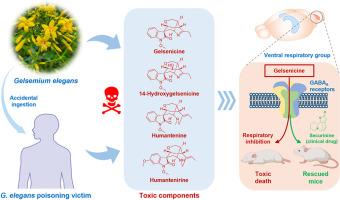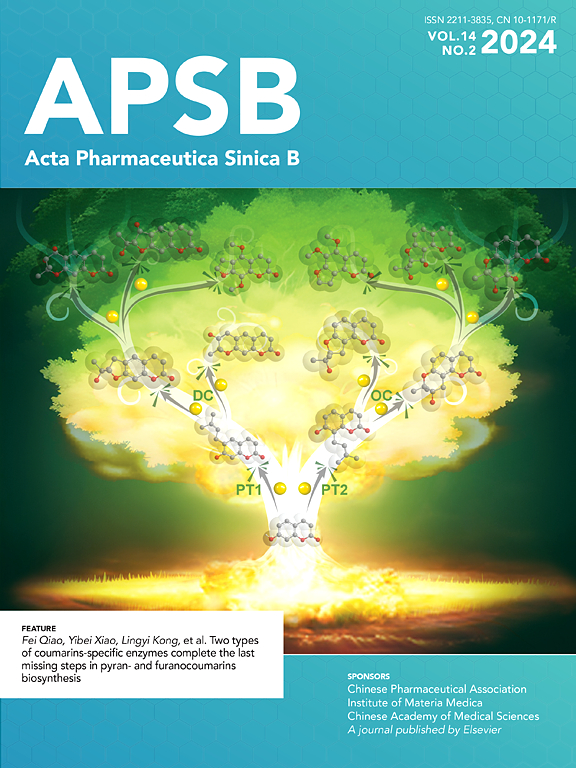秀丽隐杆线虫中毒的毒性成分、毒理机制及有效解毒剂
IF 14.6
1区 医学
Q1 PHARMACOLOGY & PHARMACY
引用次数: 0
摘要
秀丽隐杆线虫是一种剧毒植物,广泛分布于中国南部和东南亚。秀丽隐杆线虫中毒事件在中国南方经常发生,因此是一个迫切的公共卫生问题,需要采取多学科行动。然而,其毒性成分和毒理机制尚不清楚。在这里,我们描述了一个系统的调查秀丽隐杆线虫的有毒成分,导致120生物碱的分离和鉴定。在急性毒性筛选的基础上,首次提出了Gelsemium生物碱的结构-毒性关系。临床血样中检出格尔斯丁型和人藤碱型生物碱,确认为中毒原因。毒性最大的化合物格西尼辛(1)对髓质的腹侧呼吸组(VRG)神经元有选择性抑制作用,髓质是中枢神经系统中控制呼吸的主要脑区。格尔西尼辛(1)通过刺激GABAA受体(主要参与抑制性神经传递的受体)的能力,强烈抑制VRG神经元的动作电位放电。应用GABAA受体拮抗剂可逆转格西尼辛(1)处理的VRG神经元的动作电位放电。重要的是,GABAA受体拮抗剂安嘌呤和氟马西尼显著提高了中毒动物的存活率。我们的研究结果为线虫中毒的组成和机制提供了深入的见解,并有助于制定有效的秀丽隐杆线虫中毒应急治疗方案。本文章由计算机程序翻译,如有差异,请以英文原文为准。

The toxic components, toxicological mechanism and effective antidote for Gelsemium elegans poisoning
Gelsemium elegans (G. elegans) is an extremely poisonous plant that is widely distributed in southern China and southeastern Asia. G. elegans poisoning events occur frequently in southern China, and are therefore an urgent public health problem requiring multidisciplinary action. However, the toxic components and toxicological mechanisms remain unclear. Here, we describe a systematic investigation on the toxic components of G. elegans, resulting in the isolation and identification of 120 alkaloids. Based on acute toxicity screening, the structure–toxicity relationship of Gelsemium alkaloids was proposed for the first time. Moreover, gelsedine- and humantenine-type alkaloids were detected in the clinical blood sample, and were confirmed to be causative in the poisoning. The most toxic compound, gelsenicine (1), had selective inhibitory effects toward ventral respiratory group (VRG) neurons in the medulla, which is the main brain region controlling respiration in the central nervous system. Gelsenicine (1) strongly inhibited the firing of action potentials in VRG neurons through its ability to stimulate GABAA receptors, the main receptors involved in inhibitory neurotransmission. Application of GABAA receptor antagonists successively reversed action potential firing in gelsenicine (1)-treated VRG neurons. Importantly, the GABAA receptor antagonists securinine and flumazenil significantly increased the survival of poisoned animals. Our findings provide insight into the components and mechanisms of G. elegans toxicity, and should assist the development of effective emergency treatments for G. elegans poisoning.
求助全文
通过发布文献求助,成功后即可免费获取论文全文。
去求助
来源期刊

Acta Pharmaceutica Sinica. B
Pharmacology, Toxicology and Pharmaceutics-General Pharmacology, Toxicology and Pharmaceutics
CiteScore
22.40
自引率
5.50%
发文量
1051
审稿时长
19 weeks
期刊介绍:
The Journal of the Institute of Materia Medica, Chinese Academy of Medical Sciences, and the Chinese Pharmaceutical Association oversees the peer review process for Acta Pharmaceutica Sinica. B (APSB).
Published monthly in English, APSB is dedicated to disseminating significant original research articles, rapid communications, and high-quality reviews that highlight recent advances across various pharmaceutical sciences domains. These encompass pharmacology, pharmaceutics, medicinal chemistry, natural products, pharmacognosy, pharmaceutical analysis, and pharmacokinetics.
A part of the Acta Pharmaceutica Sinica series, established in 1953 and indexed in prominent databases like Chemical Abstracts, Index Medicus, SciFinder Scholar, Biological Abstracts, International Pharmaceutical Abstracts, Cambridge Scientific Abstracts, and Current Bibliography on Science and Technology, APSB is sponsored by the Institute of Materia Medica, Chinese Academy of Medical Sciences, and the Chinese Pharmaceutical Association. Its production and hosting are facilitated by Elsevier B.V. This collaborative effort ensures APSB's commitment to delivering valuable contributions to the pharmaceutical sciences community.
 求助内容:
求助内容: 应助结果提醒方式:
应助结果提醒方式:


